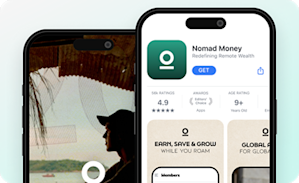Online Courses
Kajabi vs. Thinkific - Here's How They Compare
For entrepreneurs seeking to build awesome online courses, Kajabi and Thinkific are popular choices. But which one is best for your business? Let’s find out.
Author
Last Updated
May 26, 2025

Table of Contents
In this article
There’s almost no limit to where we’re seeing online courses pop up.
Influencers monetizing a following.
Skill masters looking to teach others.
College professors looking to bring their lessons online.
Companies looking to teach their employees.
Pretty much everyone is jumping on. Maybe that’s why online learning is destined to be a $1 Trillion industry by 2030.
And if you’re looking to build an online course, you’ve probably come up against one of the toughest questions there is: Where do you build it?
With the explosion of online learning has come an explosion of online courses platforms.
Two of those platforms—Kajabi and Thinkific—have drawn a great number of creators and entrepreneurs looking for a robust online course-building tool. Which, of course, begs the question: Which is better?
In this article, we’ll explore what online course platforms are and compare two popular options Kajabi vs. Thinkific.
Try the platform with the most $1 million courses and memberships
Kajabi vs. Thinkific: Quick Comparison
Kajabi | Thinkific | |
|---|---|---|
Async LMS | ||
Native Live Streaming | Separate Platform | - |
Native Live Teaching | Separate Kajabi Platform | Zoom Integration |
Communities | Separate Platform | Forums |
Activity Feed | - | - |
Chat | - | - |
Website Building | ||
Marketing Funnels | ||
Integrated Emails | ||
Custom Landing Pages | ||
Custom Branding | ||
White-Label Apps | ||
Cost | $55/mo | $49/mo |
What is an online course platform?
An online course platform is a software service that provides e-learning authoring and a learning management system (LMS) for teaching virtual courses. It may allow asynchronous or synchronous teaching (or both), and most course platforms give you the ability to structure a syllabus, add content and videos, test with quizzes and assessments, as well as a payment gateway for sales.

Online course platforms are popular because they are easy to use and much more affordable than building some type of LMS on your own. They also provide many features that would otherwise be hard to develop yourself (even with programming knowledge).
By using one of these course creation platforms, you’re giving yourself more time to focus on creating quality content and real bonds within your community.
Kajabi vs. Thinkific: Who are they?
Both Kajabi and Thinkific offer creators and entrepreneurs powerful solutions for building online courses, but their approaches are very different. So before we go too far in-depth into our analysis, let’s take a moment and explain what these platforms are known for.
Kajabi
Kajabi is an online course platform that heavily focuses on the marketing and selling of online courses.
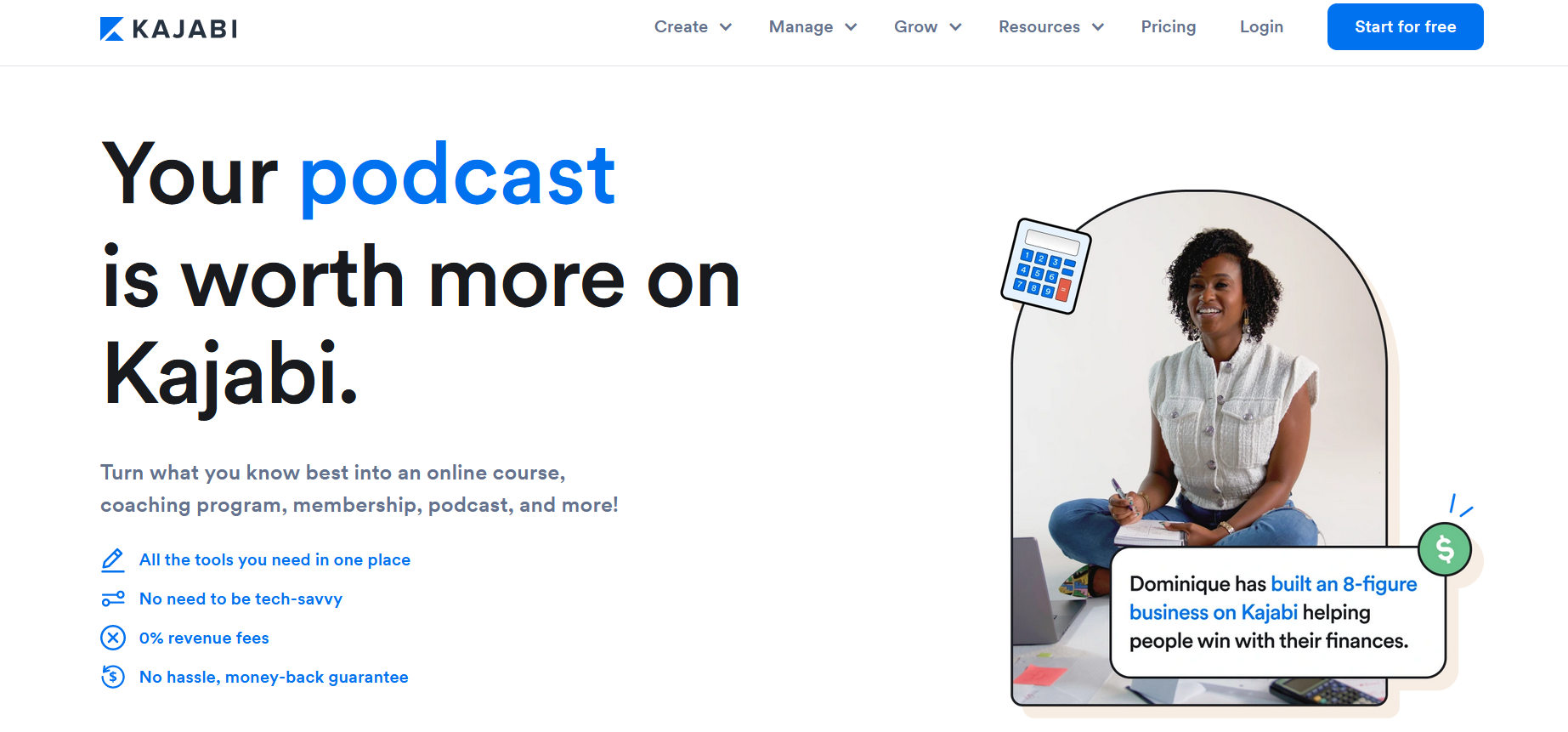
Their platform has developed extensive marketing and sales tools to couple with their online course builder so creators can make informed decisions about their business.
This means that Kajabi has put a lot of resources into developing tools for email creation and integration, landing page design, sales, and monetization, so more people can see and buy your course
Thinkific
Thinkific is an online course platform that has doubled down on content creation tools. When you build an online course on Thinkific, you’ll have access to a wide array of third-party integrations to create content. Where Kajabi shines is in its marketing tools, Thinkific probably has a bit more flexibility in what you can sell, and a better LMS.
Thinkific gives users options for delivering your courses, whether it’s through a drip method (where you release material as you create it) or all at once.
Both Thinkific and Kajabi were primarily designed for asynchronous courses, and that’s what they do best.
Kajabi vs. Thinkific: Judgment criteria
As you’re considering which online course platform is the best fit for your business, think about what you’re looking for in a platform. Whether you choose Kajabi or Thikific or some other platform, your job is much easier when you have a clear idea of what you’re looking for and how your options stack up. Here’s what we’re looking for:
Features and customization: A good course platform should let you teach in different ways, give you content flexibility, and let you add your own brand and style.
Monetization and business options: A good LMS is vital, but so are solid business tools to actually monetize your course. We’ll look at which of these two gives you the best business.
Price: Which has the better price-to-value ratio?
Apps and access: We’ll compare how Kajabi and Thinkific stack up when it comes to apps and getting your course into the hands of students.
Kajabi vs. Thinkific
Features and customization
Here we’ll compare Thinkific vs. Kajabi’s features and customization to determine which one offers you more.
Kajabi
If we had to sum up Kajabi, it would be that it’s an okay course platform with a powerhouse marketing system (which we’ll talk about next). In terms of course building, Kajabi gives you lots of templates to start with – which is great. Users can choose the one that fits their online course. The course platform itself comes with some standard content options like video and text, as well as a few delivery options like dripping content.
The other thing Kajabi does, in addition to courses, is that it gives you the option to add things like a coaching program to your offerings. This gives you a bit of extra functionality for your business and different ways to serve your customers.
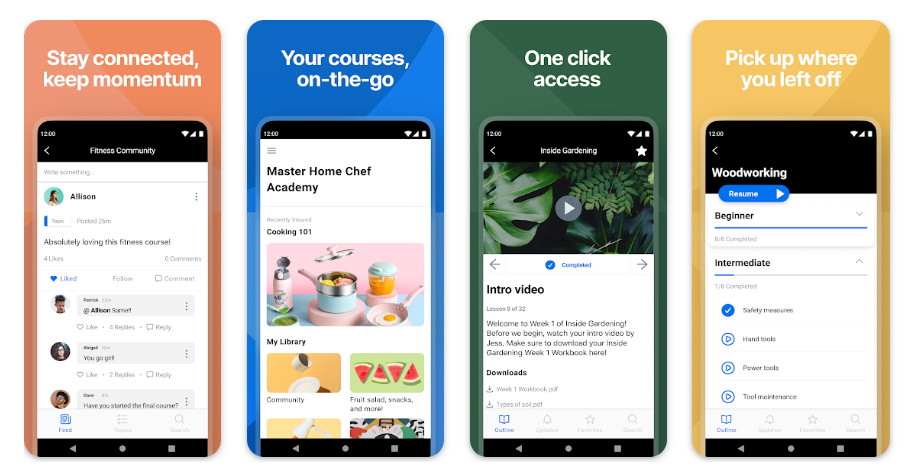
The one big downside of Kajabi’s features is that the community platform exists as a separate product. For years, Kajabi had no real community platform, but they acquired the platform Vibely to grow this out. They now offer livestreaming, events, and chats within Kajabi 2.0.
But the downside is, it requires separate logins and even two different apps--which can be confusing.
All this means that the LMS Kajabi offers is good, not great, and the inability to really immerse your course in a virtual community makes Kajabi a better option for static or asynchronous courses.
Thinkific
With Thinkific, you have the option to start out on a free plan and start building your online course. They have some solid tools such as quiz creation options, feedback surveys, and the ability to post both text and video content. Additionally, you can create discussion boards and a custom course website. The drag-and-drop website builder lets you build the site around your course.
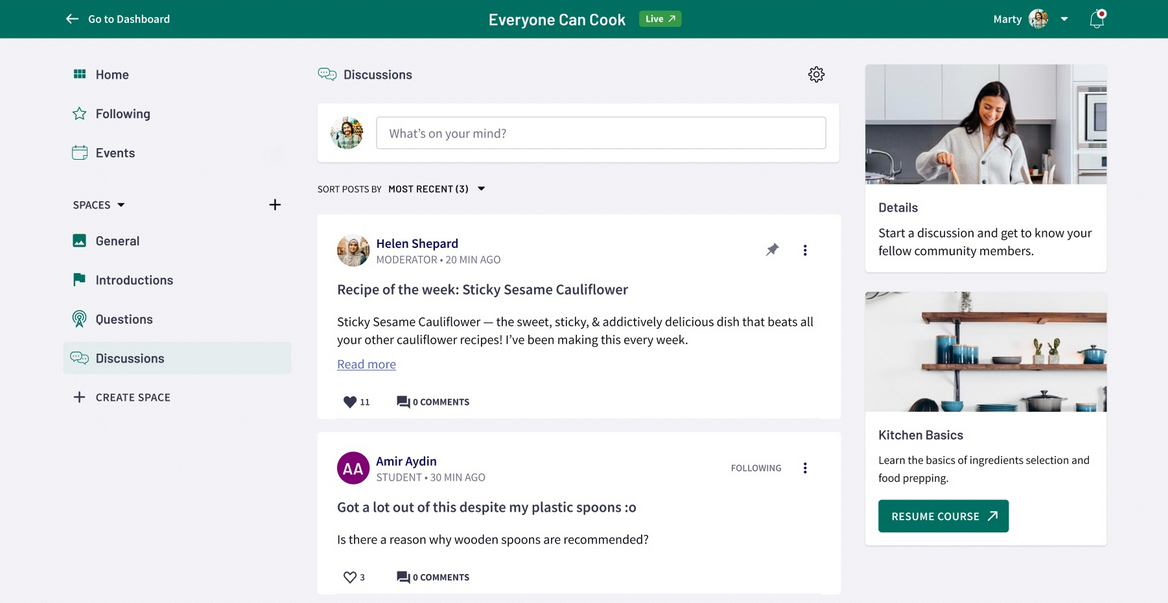
The place where Thinkific wins the feature comparison is with community. The LMS options of both platforms are somewhat comparable – although Thinkific’s LMS is probably a bit better. But by adding a community option that you can brand with your own colors, imagery, and a custom domain, it gives you something to deliver to your audience that goes beyond a simple asynchronous course.
The community is not the most comprehensive community platform, but it does have subgroups called spaces, which are virtual rooms within the community. These add to your ability to serve students, you could create dedicated tutorial groups, drop homework in, or hold office hours.
Like Kajabi, Thinkific hasn’t really put in the features for native live streaming and synchronous courses. You can link to a live stream that you host somewhere else, but Thinkific is missing native live streaming.
Which is better on features?
When it comes to comparing Thinkific vs. Kajabi on features alone, Thinkific is the clear winner. It gives you a better LMS, more customization, and pretty decent community options at a much better price than Kajabi.
Monetization and marketing
But creating your course is only one part of a course-based business. It's also important to think about how you can monetize your content and create a business around your courses.
In this section, we’ll talk about what each platform gives you for marketing your online course, as well as sales features.
Kajabi
Kajabi shines with its marketing features. With Kajabi, users can design landing pages, sales pages, email drip campaigns, and much more. It has a bunch of built-in tricks like funnels, upsells, and cart abandonment recapture. And between Kajabi and Thinkific, Kajabi’s platform offers many more integrations.

In terms of monetization, Kajabi gives you four options: mini-courses, online courses, memberships, and coaching programs. There are different ways to sell and bundle them, for example, courses can be sold at a one-time, monthly, or annual fee. They also provide options for recurring payments in the form of subscriptions and memberships.

Thinkific
Monetization will be a major factor in deciding between Thinkific or Kajabi. Luckily, Thinkific gives its creators a solid set of options for figuring out the best way to price your course. As with Kajabi, you can build landing pages and it gives you some marketing tools. You’ll be able to charge subscription fees and offer paid memberships, in addition to supplementing your sales offering with coupons, and discounts for new and old members.
But it's lacking the marketing power that Kajabi has.
Which is the better business platform?
Kajabi and Thinkific both offer interesting yet similar takes on their monetization offerings. However, Kajabi edges Thinkific out with this section by virtue of its powerhouse marketing features.
BUT it costs a lot more, and that’s what we’ll talk about next.
Price
Last but DEFINITELY not least, let’s talk about the price for each of these platforms.
Kajabi is expensive. Their cheapest plan starts at $55/month and is limited in terms of what you can do. Their most popular plan is the “Growth” tier which is $159/month and gives creators access to unlimited landing pages, marketing emails, Kajabi University (a resource center where you can read articles and guides), and more.
Thinkific is much more affordable than Kajabi with their most popular plan being $99/month. You can also sell your knowledge to your members in the form of digital downloads, full course bundles, and more. To make the deal a bit sweeter, Thinkific doesn’t charge a transaction fee either and accepts 100+ currencies. It also has a limited, free option to give you a sense of what the platform offers.
So, at the end of the day, you’ll need to compare the features you want with the price you’re willing to pay.
Native mobile
Finally, choosing an online course platform with a native mobile app will be critical to keeping your business relevant as time goes on.
Kajabi
Kajabi has a mobile app that is available on both iOS and Android. This is great because it will allow all of your members to access your online courses in whatever way suits them. You’ll be able to alert members of new activity on your course too through push notifications.

Creators can respond and react to posts right through the app, and anyone who is enrolled will be able to engage with course content through their mobile devices as well.
We mentioned the downside above. That it takes TWO different apps to run your course and community together.
This is the other Kajabi app for communities.
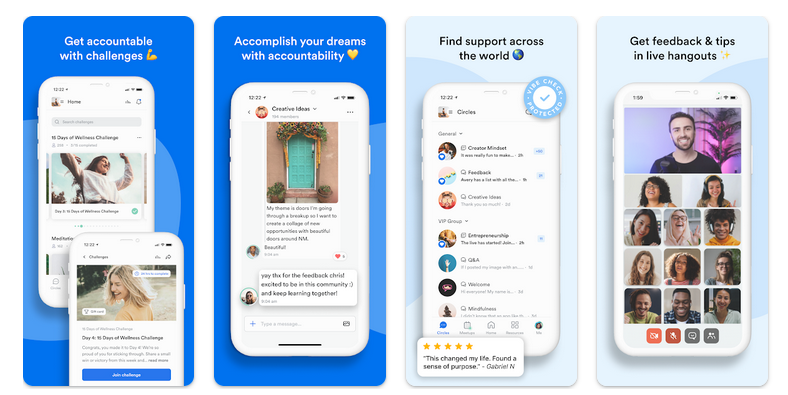
Thinkific
Thinkific was late to the game with mobile apps, first launching in 2021. And the apps they did launch are really poorly rated in both the App Store and Google Play Store (2.2 and 2.6 stars respectively).
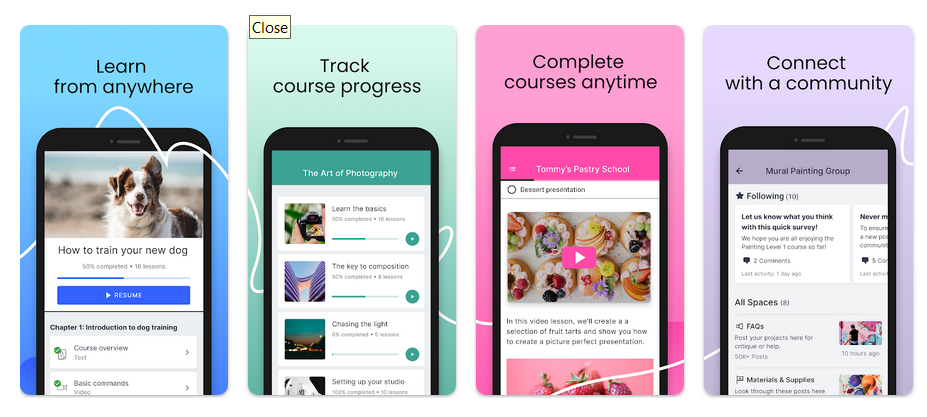
App users complain about frequent crashes, glitches, UX that is hard to figure out, and the inability to save progress in a course.
The better option for apps
Between Kajabi vs. Thinkific the answer is clear for who wins this category: Kajabi. They offer a mobile app that is fairly easy to use and available to many.
Kajabi vs. Thinkific: The winner
While both platforms offer a lot of great features for creators to build online courses, it seems that outside of pricing, Kajabi is the better of the two choices. It has a similar LMS and a powerful marketing platform. BUT it really doesn’t have community features and it’s really expensive.
Want a better option?
So what if there was a platform that brought together a powerful LMS that gave you the best features of both Kajabi + Thinkific AND gave you even more features?
What if you could get the following?
Better engagement: with G2's top-rated community platform.
Teach live courses: with native livestreaming and the LMS, instead of relying on YouTube links.
Integrated ConvertKit: with a course platform built to connect powerful email software + over 2,000 embeds.
Unmatched membership software: with automations and AI-driven engagement features like "show similarities", member profile assist, conversation starters, and the Infinite Question Generator.
Branded apps: With YOUR course app in the App Store and Google Play Store.

And Mighty comes with flexible Spaces that let you mix:
A powerful LMS
Built-in live streaming (letting you host synchronous courses AND “go live” to your students whenever you want)
A powerful community engine with all types of content, user profiles, polls and questions, and more.
Integrated live events and 1-click Zoom integration.
Courses, groups, community, and more ways to monetize and bundle your content.

Mighty's cultural software lets you bring together content, courses, community, and commerce. And it comes with an app for every device, and totally white-label apps for established course businesses.

Here are just a few more of the many things you can do with Mighty Networks:
Offer paid memberships.
Have your own branded app that is accessible in the App Store and Google Play store.
You can post videos, images, and audio clips.
Natively live stream and store video within your Mighty Network.
Create polls, discussion boards, quizzes, and Q&As.
Build fully customizable online courses with dedicated community spaces.

That’s a lot of features, and on top of all of the things you build on your Mighty Network are available across the web, iOS, and Android. More customization, flexibility, and mobility sounds pretty great, right?
Time to start building!

Ready to start building your community?
Start a free 14-day trial to explore Mighty—no credit card required.
More like this
Join Mighty Community
Learn the principles of Community Design™ (and see them in action) alongside thousands of creators and entrepreneurs. It's free to join!

Communities & Memberships
Community Platforms
Managing a Community
Building a Community
Growing a Community
Monetizing a Community
Content Creation
Online Courses
Creating a Course
Teaching a Course
Course Platforms
Selling a Course
Creators & Entrepreneurs
Monetization
Content Creation
Starting a Business
Website Builders
Creating & Managing a Website
Events
Event Platforms
Hosting & Marketing Events
Branded Apps
Creating a Mobile App
Coaching Apps
Community Apps
Coaching
Mastermind Groups
Starting a Coaching Business
Coaching Platforms
Filter by Category
Communities & Memberships
Online Courses
Creators & Entrepreneurs
Events
Branded Apps
Coaching
Build a $1 Million Community
This free masterclass went viral—sign up to learn why.


